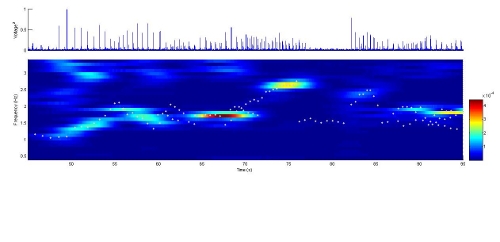Do Whales Interrupt Each Other?
Natalia Sidorovskaia - nas@louisina.edu
Philip Schexnayder - philipschexnayder@gmail.com
Department of Physics
University of Louisiana at Lafayette
Lafayette, LA 70504-4210, USA
George E. Ioup - geioup@uno.edu
Juliette W. Ioup - jwioup@uno.edu
Department of Physics
University of New Orleans
New Orleans, LA 70148
Christopher O. Tiemann - tiemann@arlut.utexas.edu
Alan Bernstein - abernste@arlut.utexas.edu
ARL, University of Texas at Austin, Austin, TX 78712
Alexander E. Ekimov - aekimov@olemiss.edu
James M. Sabatier - sabatier@olemiss.edu
NCPA, University of Mississippi, Oxford, MS 38655
Popular version of paper 1aSP4Presented Monday Morning, October 26, 2009158th ASA Meeting, San Antonio, TX
Marine mammals use sound as a primary tool for gathering information about the oceanic environment and communicating with their group members. In recent years many concerns have been raised about the interference of man-made acoustic noise on the marine mammal habitat. These concerns call for understanding how one can use sounds produced by marine mammals to infer information about their communication, social behavior, population dynamics, and migration trends. The Littoral Acoustic Demonstration Center (LADC), a group of scientists from four universities and the U.S. Navy, has been recording sounds produced by different marine mammals (sperm whales, beaked whales, dolphins etc.) using Environmental Acoustic Recording System (EARS) buoys. EARS is an acoustic recording system deployed in the ocean to silently listen for a variety of sounds in the water. Since EARS buoys do not produce any sounds themselves, this system allows one to collect sounds that animals routinely produce while going about their ocean endeavors.
LISTEN to a sperm whale cacophony with seismic booms on the background as recorded by LADC in the Gulf of Mexico.
After recording, the sounds are transferred to the LADC acoustic database and analyzed using sophisticated techniques to extract a variety of information about marine animals. LADC has pioneered the development of a computational tool that can identify individual animals in a group by exploiting differences in their calls, just as humans can recognize voices of different speakers.
One exciting aspect of individual identification is the study of social communication and acoustic manners, i.e. are whales good listeners or do they interrupt each other? Many species live in groups, collectively care for their offspring, and exhibit cohesive behavior when diving, feeding, or socializing. Since acoustics is their primary communication tool, the characteristics and patterns of their calls probably convey information about individuals in the group. Whales often emit a series of clicks, and if they overlap, it is almost impossible for a human to recognize separate rhythms. However, there have been reports of experienced West African drummers who could identify rhythmic patterns belonging to different animals in a cacophony of marine mammal sounds. Since LADC does not have a drummer in the research group, it developed tools to find rhythms in the clicks of sperm and beaked whales and associate those with individuals.

Figure 1. Output of LADCs rhythmic analysis program: bright spots identify the frequencies of sperm whale clicks
The analysis suggests that whales vary the interval between their clicks slightly, perhaps so they do not clutter the acoustic echoes of their group-mates. In other words, whales are polite listeners; they do not interrupt each other. One can even hypothesize that whales collectively use sounds produced by all members in a group to explore the environment faster and more efficiently.
(LADC research efforts were partly supported by grants from the Office of Naval Research, SPAWAR, and the Louisiana Optical Network Initiative.)